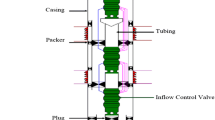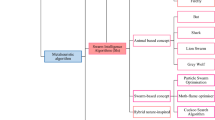Abstract
A heuristic-based simulated annealing has been developed to optimize the operation of a multiple reservoir system. Simulated annealing is a probabilistic search algorithm, motivated by an analogy of physical annealing in solids. It has been increasingly applied to a broad spectrum of fields for which little prior knowledge is required. The developed model is illustrated by a test application to a benchmark problem of a 10-reservoir problem that had been solved previously in the literature. For this problem, simulated annealing shows its ability to provide better result than those obtained from other techniques. The model is then applied to the real multiple reservoir system in Thailand to derive optimal operating policies. The objective function is formulated to minimize the irrigation deficits during 3 years. The performance of the simulated annealing is compared with that of the genetic algorithm developed for the same problem. The results show that the simulated annealing is more efficient than the genetic algorithm. Simulated annealing produces higher quality solutions while spending lesser computation time compared with the genetic algorithm. The results obtained from these applications have proved that the simulated annealing is capable of addressing a large and complex problem. Simulated annealing is quite a new promising search algorithm for reservoir optimization problems. It is worthy of further investigation for other applications in this area of research.






Similar content being viewed by others
References
Braun TD, Siegel HJ, Beck N, Bölöni LL, Maheswaran M, Reuther AI, Robertson JP, Theys MD, Yao B (2001) A comparison of eleven static heuristics for mapping a class of independent tasks onto heterogeneous distributed computing systems. J Parallel Distributed Comput 61(6):810–837
Bárdossy A (1998) Generating precipitation time series using simulated annealing. Water Resour Res 34(7):1737–1744
Burke E, Kendall G (1999) Comparison of meta-heuristic algorithms for clustering rectangles. Comput Ind Eng 37(1,2):383–386
Cai X, Mckinney DC, Lasdon LS (2001) Solving nonlinear water management models using a combined genetic algorithm and linear programming approach. Adv Water Resour 24(6):667–676
Cieniawski SE, Eheart JW, Ranjithan S (1995) Using genetic algorithms to solve a multiobjective groundwater monitoring problem. Water Resour Res 31(2):339–409
Chan F-J, Chen L (1998) Real-code genetic algorithm for rule-based flood control reservoir management. Water Resour Manage 12(3):185–198
Chen H, Flann NS, Watson DW (1998) Parallel genetic simulated annealing: a massively parallel SIMD algorithm. IEEE Trans Parallel Distributed Syst 9(2):126–136
Cunha MDC (1999) On solving aquifer management problems with simulated annealing algorithms. Water Resour Manage 13(3):153–169
Cunha MDC, Sousa J (1999) Water distribution network design optimization: simulated annealing approach. J Water Resour Plan Manage ASCE 125(4):215–221
Dandy GC, Simpson AR, Murphy LJ (1996) An improved genetic algorithm for pipe network optimization. Water Resour Res 32(2):449–458
Dougherty DE, Marryott BA (1991) Optimal groundwater management: 1. Simulated annealing. Water Resour Res 27(10):2493–2508
Electricity Generating Authority of Thailand (2001) Report of rule curve improvement study of Srinagarindra reservoir and Vajiralongkorn reservoir. (in Thai)
Electricity Generating Authority of Thailand (1992) Research report of criteria for water release from reservoirs in Mae Klong river basin. (in Thai)
Eriksson P, Arora JS (2002) A comparison of global optimization algorithms applied to a ride comfort optimization problem. Struct Multidisc Optim 24:157–167
Goldberg DE, Kuo CH (1987) Genetic algorithms in pipeline optimization. J Comput Civil Eng ASCE 1(2):128–141
Goldberg DE (1989) Genetic algorithms in search, optimization, and machine learning, 2nd edn. Addison-Wesley, Reading, MA
Huang WC, Yuan LC, Lee CM (2002) Linking genetic algorithms with stochastic dynamic programming to the long-term operation of a multireservoir system. Water Resour Res 38(12):40-1–40-9
Inoue K, Kobayashi A, Aoyama S (2003) Applicability of genetic algorithm for identifying the groundwater contamination source. J Rainwater Catch Syst 8(2):7–14
Kirkpatrick S, Gelatt CD, Vecchi MP (1983) Optimization by simulated annealing. Science 220(4598):671–680
Kuo SF, Liu CW, Markley GP (2001) Application of the simulated annealing method to agricultural water resoures management. J Agric Eng Res 80(1):109–124
Lee YM, Ellis JH (1996) Comparison of algorithms for nonlinear integer optimization: application to monitoring network design. J Environ Eng ASCE 122(6):524–531
Mantawy AH, Soliman SA, El-Hawary ME (2003) An innovative simulated annealing approach to the long-term hydroscheduling problem. Electr Power Energy Syst 25(1):41–46
Marryott RA, Dougherty DE, Stollar RT (1993) optimal groundwater management: 2. application of simulated annealing to a field-scale contamination site. Water Resour Res 29(4):847–860
Mayer DG, Belward JA, Burrage K (1999) Performance of genetic algorithms and simulated annealing in the economic optimizatin of a herd dynamics model. Environ Int 25(6/7):899–905
Mckinney DC, Lin M-D (1994) Genetic algorithm solution of groundwater management models. Water Resour Res 30(6):1897–1906
Michalewicz Z (1996) Genetic algorithms + data structures = evolutionary programs, 3rd edn. Springer, Berlin Heidelberg New York
Montesinos P, Guzman AG, Ayuso JL (1999) Water distribution network optimization using a modified genetic algorithm. Water Resour Res 35(11):3467–3473
Murray DM, Yakowitz SJ (1979) Constrained differential dynamic programming and its application to multireservoir control. Water Resour Res 15(5):1017–1028
Oliveira R, Loucks DP (1997) Operating rules for multireservoir systems. Water Resour Res 33(4):839–852
Ponnambalam SG, Reddy MM (2003) A GA-SA multiobjective hybrid search algorithm for Integrating lot sizing and sequencing in flow-line scheduling. Int J Adv Manuf Technol 21:126–137
Ritzel BJ, Eheart JW, Ranjithan S (1994) Using genetic algorithms to solve a multiple objective groundwater pollution containment problem. Water Resour Res 30(5):1589–1603
Rizzo DM, Dougherty DE (1996) Design optimization for multiple management period groundwater remediation. Water Resour Res 32(8):2549–2561
Savic DA, Walters GA (1997) Genetic algorithms for least-cost design of water distribution networks. J Water Resour Plan Manage ASCE 123(2):67–77
Sharif M, Wardlaw R (2000) Multireservoir systems optimization using genetic algorithms: case study. J Comput Civil Eng ASCE 14(4):225–263
Simpson AR, Dandy GC, Murphy LJ (1994) Genetic algorithms compared to other techniques for pipe optimization. J Water Resour Plan Manage ASCE 120(4):423–443
Teegavarapu RSV, Simonovic SP (2002) Optimal operation of reservoir system using simulated annealing. Water Resour Manage 16(5):401–428
Tospornsampan J, Kita I, Ishii M, Kitamura Y (2004) Operating rule curves for multiple reservoir system, a case study in Mae Klong river basin, Thailand. J Rainwater Catch Syst 9(2):11–19
Tospornsampan J, Kita I, Ishii M, Kitamura Y (2005) Optimization of multiple reservoir system operation using combination of genetic algorithm and discrete differential dynamic programming: a case study in Mae Klong system, Thailand. J Int Soc Paddy Water Environ Eng 3(1):29–38
Wardlaw R, Sharif M (1999) Evaluation of genetic algorithms for optimal reservoir system operation. J Water Resour Plan Manage ASCE 125(1):25–33
Westhead DR, Clark DE, Murray CW (1997) A comparison of heuristic search algorithms for molecular docking. J Comput-Aided Mol Design 11:209–228
Wurbs RA (1994) Reservoir-system simulation and optimization models. J Water Resour Plan Manage ASCE 119(4):455–472
Yeh WWG (1985) Reservoir management and operations models: a state-of-the-art review. Water Resour Res 21(12):1797–1818
Yeh WWG, Becker L, Chu WS (1979) real-time hourly reservoir operation. J Water Resour Plan Manage Div ASCE 105(WR2):187–203
Acknowledgements
The authors would like to extend their appreciation and gratitude to the Electricity Generating Authority of Thailand for providing data used in this study.
Author information
Authors and Affiliations
Corresponding author
Rights and permissions
About this article
Cite this article
Tospornsampan, J., Kita, I., Ishii, M. et al. Optimization of a multiple reservoir system using a simulated annealing--A case study in the Mae Klong system, Thailand. Paddy Water Environ 3, 137–147 (2005). https://doi.org/10.1007/s10333-005-0010-x
Received:
Accepted:
Published:
Issue Date:
DOI: https://doi.org/10.1007/s10333-005-0010-x




